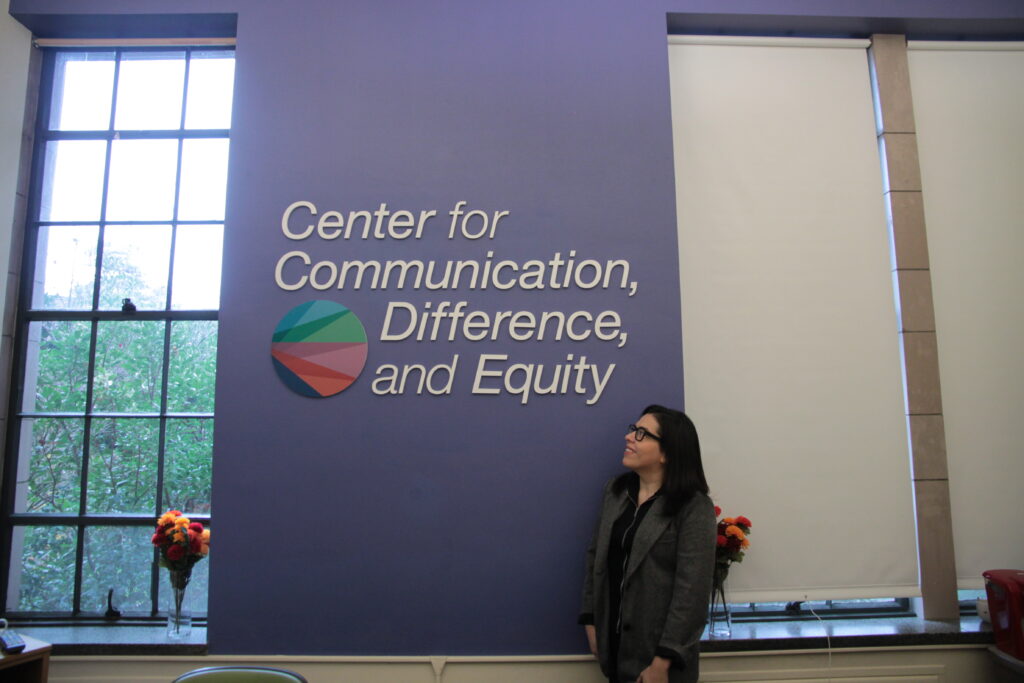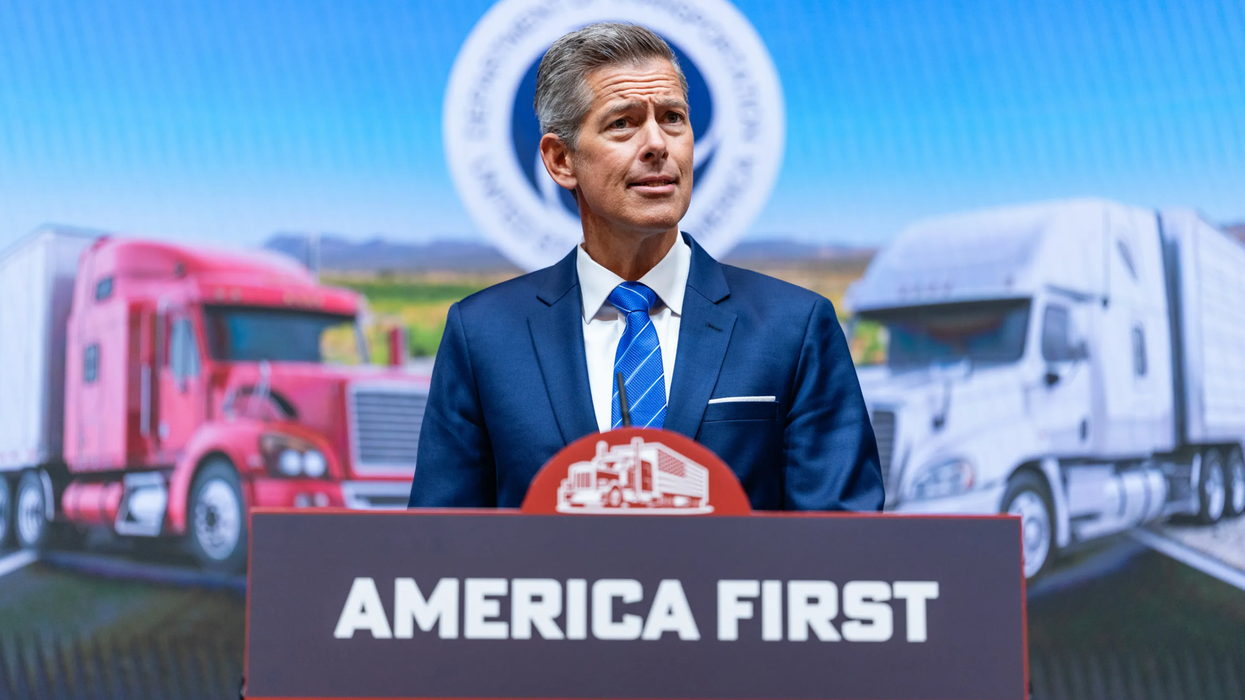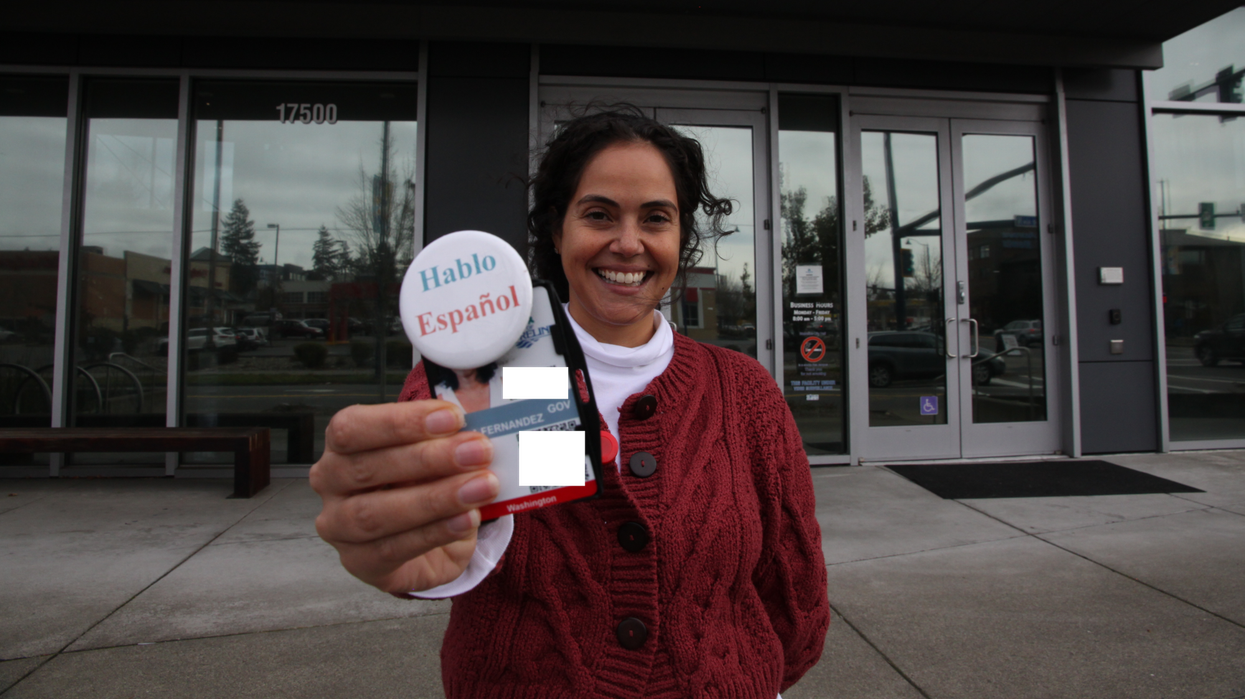In this video from Healing Race, Andre and Todd reflect on their conversation in the first episode, discussing the parallels between Black and Jewish histories of discrimination and hate and how they think about those histories when it comes to our country today. Andre asks Todd about times when he’s felt fears for his own safety and relate his stories to his experience as a Black man in this country.
Site Navigation
Search
Latest Stories
Start your day right!
Get latest updates and insights delivered to your inbox.
Top Stories
Latest news
Read More
University Roundtable Puts Latino Mental Health Front and Center
Dec 17, 2025
“Keep it to yourself. Push it down. Don’t say anything.” That is how Isis Lara Fernandez was taught to live with her status as an undocumented immigrant in the United States.
At 6-years-old, Lara Fernandez fled to the U.S. with her mother and siblings to escape domestic violence in Honduras. From that point forward, Lara Fernandez navigated life with a persistent fear that her secret could be discovered at any point in time.
“There was this impending amount of fear that was happening that you kind of learned to suppress,” Lara Fernandez said in an interview. “My mom didn’t know how to manage it, so she just learned to not say anything. That was a terrible strategy but that’s the only one I knew.”
On Oct. 22, the University of Washington’s Center for Communication, Difference and Equity (CCDE) hosted a roundtable discussion on the state of mental health in Latino communities. The roundtable covered the work being done across governmental, medical and non-profit agencies to provide critical resources to Latino individuals in need.
Latino individuals have been increasingly targeted by President Donald Trump’s mass deportation measures. According to a 2025 analysis conducted by the UCLA Luskin School of Public Affairs’ Center for Neighborhood Knowledge, Latinos accounted for nine out of ten Immigration and Customs Enforcement (ICE) arrests over the past six months.
Gloria Martinez Sierra, an outreach manager of the bilingual program for Parents of Adolescents and Teens (PAT) at Programs for Early Parent Support (PEPS) in Seattle, said she has seen a decline in community participation from Latino individuals at in-person events due to an increased anxiety of deportation.
Isabella Herrera, a licensed mental health counselor at UW Medicine Harborview Medical Center’s Edward Thomas House Respite, has noticed a similar decline in the number of Latino individuals she treats. The Edward Thomas House Respite provides acute medical care to individuals experiencing homelessness, treating a range of ailments such as cancer, substance abuse and psychiatric disorders.
She said that many of her patients know friends or family members who have been deported or detained, which has deterred them from going to their doctor’s appointments and receiving the critical medical care they need. As a result, health disparities in Latino communities have been exacerbated.
“For a lot of our people, engaging in their medical care is essential,” Herrera said in the roundtable. “It’s not just a primary care appointment, it’s a life-sustaining kind of treatment.”
Lara Fernandez has seen a similar trend from undocumented immigrant mothers as the equity and social justice coordinator at the City of Shoreline. Many have requested that she not enroll them in federally-funded programs like SNAP, EBT or Medicaid.
“That is the stuff that really broke my heart because this is a very vulnerable population that had no access and an excessive amount of barriers in front of them,” Lara Fernandez said in the roundtable.
Dr. Carmen Gonzalez, the director of UW’s CCDE and an associate professor in the department of communication, said culture plays a significant role in limiting conversations about mental health in Latino communities. This resistance has caused many to suffer in silence.
“If we can’t name anxiety, then it’s really tricky to come out of it or to develop coping mechanisms for how to deal with it,” Gonzalez said in an interview.
She began studying anti-immigrant rhetoric in the media as a graduate student to understand how ethnic media can mobilize protests and encourage marginalized communities to speak out against anti-immigration legislation.
 Dr. Carmen Gonzalez is the director of UW’s CCDE and an associate professor in the department of communication. Photo by Corey Olson.
Dr. Carmen Gonzalez is the director of UW’s CCDE and an associate professor in the department of communication. Photo by Corey Olson.She said social media platforms like TikTok help promote conversations about mental health to fill in generational gaps within immigrant communities, but also spread massive amounts of misinformation that can contribute to cultural stigmas and taboos.
“I think we’re in a much better place than when I started doing research in this area, because I feel like mental health is just less taboo,” Gonzalez said in an interview.
During the roundtable, Lara Fernandez shared her experience being detained in 2014 and the role her upbringing played in how she dealt with the situation. She was detained in Texas while returning to Washington state after visiting family in Honduras. She was held in a processing center for about one month and was released after her sister set up a successful GoFundMe page to raise money for an immigration lawyer.
After her release, Lara Fernandez began working in social services, assisting immigrant and refugee unaccompanied minors at the Washington state border as they were transferred into the state’s foster care system. She focused on her work in an effort to forget the experience of being detained, but later began using alcohol as a way to cope.
“In a way, I was trying to give back to the same people that were suffering something I had just suffered,” Lara Fernandez said in an interview. “Since I was doing that, I thought I would be okay. But I was not attending to my feelings and was suppressing them a lot.”
Lara Fernandez became sober in 2018 and is currently doing research on substance use disorders and addiction in Black and Brown communities as part of her Ph.D. in leadership and change program at Antioch University.
Despite experiencing an increase in her post-traumatic stress disorder symptoms from her work with undocumented individuals, she has found healing in openly talking about her experience in spaces like the roundtable.
“It’s like I’m feeling so happy of how much I’ve overcome, but without crying,” Lara Fernandez said in an interview.
She believes it’s important for Latino communities to understand that healing can look different for different people, despite the cultural norms surrounding conversations about mental health.
“It’s kind of ingrained in our culture,” Lara Fernandez said in an interview. “I’m probably privileged speaking out about being detained because I am no longer undocumented, but speaking truth to the things that were hidden in the shadows is helpful to any healing process.”
At the end of the roundtable, Gonzalez asked each speaker what brought them hope during this difficult time for Latino communities. Every response had one thing in common: the roundtable.
“This live stream just in itself is a way of giving hope to others,” Lara Fernandez said at the roundtable. “It gives me hope that we might continue this series because I think it’s beneficial. And maybe the next one will be in all Spanish, para nuestra gente verdad.”
University Roundtable Puts Latino Mental Health Front and Center was first published on Washington Latino News and was republished with permission.
Corey Olson is a fourth-year student pursuing a double major in Journalism and Public Interest Communication and Law, Societies, and Justice at the University of Washington, Seattle.
Keep ReadingShow less
Recommended

An Israeli airstrike hit Deir al-Balah in central Gaza on Jan. 1, 2024.
Majdi Fathi/NurPhoto via Getty Images
A Democrat's Plan for Ending the War in Gaza
Dec 16, 2025
Trump's 21-point peace plan for Gaza has not and will not go anywhere, despite its adoption by the UN Security Council. There are two reasons. One is that Israeli Prime Minister Benjamin Netanyahu and his ultra-orthodox nationalist allies will not agree to an eventual Palestinian state in the occupied territories. The other is that Hamas will not stand down and give up its arms; its main interest is the destruction of Israel, not the creation of a home for the Palestinian people.
Democrats should operate as the "loyal opposition" and propose a different path to end the "war" and establish peace. So far, they have merely followed the failed policies of the Biden administration.
At the DNC’s last annual meeting, there were two resolutions on the Gaza conflict. The Progressive wing’s resolution called for an arms embargo and the suspension of military aid to Israel. The other called for an immediate ceasefire, the unconditional release of all hostages, unrestricted delivery of humanitarian assistance to civilians in Gaza, and reaffirmed support for a two-state solution.
Neither resolution presented a comprehensive Democratic position on how the U.S. should attempt to bring about an end to the conflict and permanent peace.
The Progressive’s resolution was inadequate because it just went for the jugular and did not address other key issues and context. The mainstream resolution included the necessary context and hit important marks, but it failed to address the crucial point raised by the Progressives—that Democrats and the U.S. should not continue to support Israel militarily in this war. Note: this is not about not supporting Israel militarily; it is solely about not supporting it with arms in this war.
Proposing military sanctions is necessary because Netanyahu’s only concern is keeping himself in power, and he sees it in his interest to prolong the conflict. Sanctions are the only way to impact his thinking. This will never happen under Trump, but Democrats, as the opposition, must be the voice of reason.
U.S. law prohibits arms sales in various situations. First, defense articles may be sold for specific purposes only, including “internal security and legitimate self-defense.” Second, no security assistance may be provided to any country whose government engages in a “consistent pattern of gross violations of internationally recognized human rights.”
As applied to the Israel-Gaza conflict, Israel’s military actions crossed the line long ago from being “legitimate self-defense” to being an offensive war. And the claim can be made that Israel has engaged in a “consistent pattern of gross violations” of internationally recognized human rights.
There is thus a way to combine mainstream and progressive perspectives in a resolution that would be reasoned and justified under U.S. law. Such a resolution would anger Democratic supporters of Netanyahu and the ultra-orthodox, but there is no way to placate them and still end the war while Netanyahu is in power.
Being a big tent is only a strength if those different perspectives, rather than causing division, are blended into a more comprehensive position. But the division within the Party was on full display before the DNC Chair created a task force to resolve the differences.
As a Jew and the child of holocaust survivors, I am a strong supporter of Israel’s right to exist. But as a supporter of a two-state solution, I have been a critic of right-wing Israeli governments over the years that have expanded West Bank settlements with a view to making a two-state solution logistically impossible. Just recently, Netanyahu authorized the largest increase in settlements in decades.
I have been against such actions because displacing Palestinians is inhumane and illegal, and if the goal is security, such actions are ultimately counterproductive.
There is lots of blame to pass around on all sides of this conflict. See my post, "Is There a Solution to the Ongoing Middle East Crisis?" There is a long history of actions by Israel, the surrounding Arab states, and Palestinians that have fed the implacable hostility between the parties.
For both Israelis and Palestinians, how do you make peace with someone who does not recognize your right to exist? I know that the Palestine Liberation Organization removed the offensive phrase from their charter, but that was for many more show than substance, and it did not include Hamas. And the far-right leaders of Israel have certainly not shown a recognition of Palestinians’ right to exist.
The answer is that one needs to find ways to build trust. Unfortunately, since the Oslo Accords (1993/1995), both sides have done more to destroy trust. One positive change is that five Arab states have now recognized Israel’s right to exist and have diplomatic relations with it. And recently, the Arab League called on Hamas to lay down its arms and relinquish control of Gaza. Israel, unfortunately, has done nothing to build trust.
Building trust cannot be done with Netanyahu at Israel’s helm, nor with Hamas at the Palestinians’ helm. If Hamas heeded the Arab League's statement, that would be a major trust-building action. Israeli voters getting rid of Netanyahu would be another.
Regardless, the short-term goal must be ending the Gaza "war," the first step in building a peace that includes the rebuilding of Gaza and a two-state solution. To that end, Democrats must, as part of their peace plan, call for a halt to arms sale to Israel for use in the war.
At the same time, Democrats must call on the Arab League to follow through on their resolution by stopping the flow of arms and money from Arab states to Hamas.
With Hamas and Netanyahu both weakened, Israelis and Palestinians who are tired of war will hopefully be willing, through elections (they are scheduled in Israel in 2026), to support an effort to build a lasting peace with security between the two, based on a two-state solution.
To build trust, Palestinian-Israelis should be made full-fledged citizens of Israel. And a robust people-to-people program that ends the isolation of the two peoples should be implemented, based on existing prototypes. The dynamic of the relationship must change.
One caveat is necessary: In order to create a logistically viable Palestinian state in the West Bank and Gaza, most of the Jewish settlements (illegal under international law) will have to be evacuated, much as then-Prime Minister Ariel Sharon unilaterally pulled back from Gaza, abandoning the Jewish settlements there.
But things are different now; the settler movement has more power and is more violent. Even in 1995, then-Prime Minister Yitzhak Rabin was assassinated by a right-wing nationalist over this issue. The situation is even more explosive now.
For an Israeli government to accomplish this will be more than difficult. Just like conservative President Richard Nixon was the only person who could have opened up U.S. relations with China, so too a center/right Israeli government is probably the only one that could abandon the West Bank.
The goal of right-wing Prime Ministers from Menachem Begin to Netanyahu in expanding settlements in the West Bank has been to make the creation of a Palestinian state almost impossible. Hopefully, they have not achieved their goal.
Ronald L. Hirsch is a teacher, legal aid lawyer, survey researcher, nonprofit executive, consultant, composer, author, and volunteer. He is a graduate of Brown University and the University of Chicago Law School and the author of We Still Hold These Truths. Read more of his writing at www.PreservingAmericanValues.com.
Keep ReadingShow less

Killing suspected drug traffickers without trial undermines due process, human rights, and democracy. The war on drugs cannot be won through extrajudicial force.
Getty Images, SimpleImages
Killing Suspected Traffickers Won’t Win the War on Drugs
Dec 16, 2025
Life can only be taken in defense of life. That principle is as old as civilization itself, and it remains the bedrock of justice today. To kill another human being is justifiable only in imminent self‑defense or to protect the lives of innocent people. Yet the United States has recently crossed a troubling line: authorizing lethal strikes against suspected drug traffickers in international waters. Dozens have been killed without trial, without legal counsel, and without certainty of guilt.
This is not justice. It is punishment without due process, death without defense or judicial review. It is, in plain terms, an extrajudicial killing. And it is appalling.
Killing people for transporting drugs to those who willingly buy them does not dismantle the networks that profit from addiction. It does not reduce demand. It does not heal communities. What it does is erode America’s moral authority and undermine the very values of fairness and dignity that our laws are meant to protect.
The Failure of Punitive Force
The “war on drugs” has long relied on punitive measures — arrests, incarceration, interdiction, and now lethal strikes. Yet decades of evidence show that these tactics fail to reduce supply or demand. Drug networks adapt, new traffickers emerge, and communities remain trapped in cycles of addiction and violence. What changes is the body count, not the underlying crisis.
By authorizing killings at sea, the United States risks normalizing extrajudicial force as a tool of policy. That precedent is dangerous. If one nation claims the right to kill suspects without trial in international waters, others may follow suit. The rule of law erodes, replaced by the rule of force and impunity.
Evidence From Abroad
There is another path. Portugal, by decriminalizing drug possession in 2001 and investing in treatment, saw overdose deaths and HIV infections plummet. Incarceration rates dropped, while voluntary treatment engagement rose.
Switzerland, by embracing harm‑reduction and heroin‑assisted therapy, reduced violence, stabilized communities, and improved health outcomes. These nations chose to value life over lethal force, dignity over deterrence.
Their success shows that evidence‑based policy can save lives while upholding human rights and democratic legitimacy.
A Call for Civic Integrity
The principle of civic integrity demands a different path. Laws should protect choice, not prescribe identity. Policies should safeguard life, not take it without cause. Respect for tradition and security can be encouraged through dialogue, education, and voluntary practice. But respect imposed by mandate — or enforced by missile — is not respect at all. It is coercion masquerading as respect. And coercion breeds division rather than unity.
The Universal Declaration of Human Rights affirms freedom of thought, conscience, religion, and expression. These rights are not abstract ideals; they are practical safeguards against the misuse of power. When institutions dictate identity or authorize killings without trial, they undermine the very freedoms they are meant to protect. When they safeguard choice and dignity, they strengthen trust and legitimacy.
The Path Forward
The lesson is clear: the war on drugs cannot be won with missiles and gunfire. It can only be won by affirming the sanctity of life, by treating addiction as a health issue, and by dismantling the financial networks that exploit human suffering. America must choose whether it will be a nation that protects life or one that takes it without cause.
The Fulcrum exists to elevate voices committed to strengthening democracy. That work begins with restoring faith in our institutions, our commitments, and our word. Life is sacred. And if democracy is to endure, our policies must reflect that truth.
Bruce Lowe is a homeowner advocate and community leader in Lubbock, Texas. He writes about civic integrity, public health, and principled reform. His book, "Honesty and Integrity: The Pillars of a Meaningful Life", explores how ethical leadership can strengthen families, uplift communities, and create a better life for all.
Keep ReadingShow less

A deep look at what “American values” truly mean, contrasting liberal, conservative, and MAGA interpretations through the lens of the Declaration and Constitution.
LeoPatrizi/Getty Images
The Season to Remember We’re Still One Nation
Dec 16, 2025
Every year around this time, the noise starts to drop. The pace eases a bit. Families gather, neighbors reconnect, and people who disagree on just about everything still manage to pass plates across the same table. Something about late November into December nudges us toward reflection. Whatever you call it — holiday spirit, cultural memory, or just a pause in the chaos — it’s real. And in a country this divided, it might be the reminder we need most.
Because the truth is simple: America has never thrived by choosing one ideology over another. It has thrived because our competing visions push, restrain, and refine each other. We forget that at our own risk.
I grew up in a time when political conversations were part of life, not a reason to exile someone from it. You could disagree without severing the relationship. The center wasn’t seen as a weakness. It was maturity — the space where people with different temperaments and values tried to make something workable.
Today, we act as if our country must pick a single path and purge the rest. But that’s not how the United States was designed. It wasn’t intended as a pure libertarian project or a pure social democracy. It’s a deliberate blend — a push-and-pull system with enough room for Hamilton’s national strength, Jefferson’s local skepticism, Roosevelt’s compassion, and Reagan’s correction.
The very friction we complain about is the mechanism that keeps us balanced.
And you can even see that balance in our books. Wealthier, urban, blue-leaning states indeed tend to generate more federal revenue than they receive. But those same states depend just as heavily on the energy, agriculture, manufacturing, and natural resources that come from the rural, older, red-leaning states that receive more federal spending. That’s not ideology — that’s geography, demographics, and economic interdependence. Neither side is self-sufficient, and neither thrives without the other. The numbers simply reveal how tightly woven the country really is.
Some Americans daydream about a national split — two countries, one red and one blue — each free to express pure ideology without interference. It’s a tempting fantasy until you follow the math. A “blue nation” might be wealthy on paper, but it would be burdened by the cost of living, bureaucracy, and a shortage of land-based industries. A “red nation” might feel culturally unified, but would immediately face fiscal strain, aging demographics, and the challenge of replacing the federal inflows that currently stabilize its budgets.
Cut the country in half ideologically, and each half becomes a weaker version of itself.
Together, they make the thing work.
This time of year has a way of softening the edges, even if only for a few weeks. It reminds us that the people who frustrate us most are often the same people we share a meal with, raise kids around, or bump into at the grocery store. We don’t disappear from each other in December. We draw a little closer, whether we like it or not. That closeness is a quiet lesson in what the country needs year-round.
The center isn’t a compromise of conviction. It’s the only place 330 million people with wildly different values can coexist without tearing the nation apart. It’s the adult table — the one where no single worldview gets everything it wants, but everybody gets enough stability to keep moving.
As this season unfolds, I find myself hoping we rediscover that center. We don’t have to agree on every policy or election. But we do need to stop pretending one side can run the country alone. America’s strength has always come from its opposites — from the tension between compassion and discipline, progress and caution, liberty and responsibility.
That tension isn’t a flaw. It’s the American design.
Maybe this quieter stretch of the year gives us the breathing room to remember it. And maybe that’s enough to soften the tone, steady the hand, and remind us that disagreement is not the end of the relationship — it’s the beginning of the conversation.
Joe Palaggi is a writer and historian whose work sits at the crossroads of theology, politics, and American civic culture. He writes about the moral and historical forces that shape our national identity and the challenges of a polarized age.
Keep ReadingShow less
Load More

















